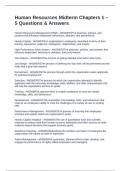Human Resources Midterm Chapters 1 –
5 Questions & Answers
Human Resources Management (HRM) - ANSWERSThe practices, policies, and
systems that influence employees' behaviours, attitudes, and performance.
Human Capital - ANSWERSAn organization's employees, described in terms of their
training, experience, judgment, intelligence, relationships, and insight.
High-Performance Work System - ANSWERSThe practices, policies, and systems that
influence employees' behaviours, attitudes, and performance.
Job Analysis - ANSWERSThe process of getting detailed information about jobs.
Job Design - ANSWERSThe process of defining the way work will be performed and the
tasks that a given job requires.
Recruitment - ANSWERSThe process through which the organization seeks applicants
for potential employment.
Selection - ANSWERSThe process by which the organization attempts to identify
applicants with the necessary knowledge, skills, abilities, and other characteristics that
will help the organization achieve its goals.
Training - ANSWERSA planned effort to enable employees to learn job-related
knowledge, skills, and behaviours.
Development - ANSWERSThe acquisition of knowledge, skills, and behaviours that
improve an employee's ability to meet the challenges of a variety of new or existing
jobs.
Performance Management - ANSWERSThe process of ensuring that employees'
activities and outputs match the organization's goals.
Human Capital Analytics - ANSWERSThe use of quantitative tools and scientific
methods to analyze data from human resource databases and other sources to make
evidence-based decisions that support business goals.
Workforce Planning - ANSWERSIdentifying the numbers and types of employees the
organization will require to meet its objectives.
Talent Management - ANSWERSA systematic, planned effort to train, develop, and
engage the performance of highly skilled employees and managers.
, Evidence-Based HR - ANSWERSCollecting and using data to show that human
resource practices have a positive influence on the company's bottom line or key
stakeholders.
Sustainability - ANSWERSAn organization's ability to profit without depleting its
resources, including employees, natural resources, and the support of the surrounding
community.
Stakeholders - ANSWERSThe parties with an interest in the company's success
(typically, shareholders, the community, customers, and employees).
Productivity - ANSWERSThe relationship between an organization's outputs (products,
information, or services) and its inputs (e.g., people, facilities, equipment, data, and
materials).
Expatriates - ANSWERSEmployees who take assignments in other countries.
Outsourcing - ANSWERSThe practice of having another company (a vendor, third-party
provider, or consultant) provide services.
Offshoring - ANSWERSSetting up a business enterprise in another country (e.g.,
building a factory in China).
Ethics - ANSWERSThe fundamental principles of right and wrong.
Internal Labour Force - ANSWERSAn organization's workers (its employees and the
people who work at the organization).
External Labour Force - ANSWERSIndividuals who are actively seeking employment.
Knowledge Workers - ANSWERSEmployees whose main contribution to the
organization is specialized knowledge, such as knowledge of customers, a process, or a
profession.
Employee Engagement - ANSWERSFull involvement in one's work and commitment to
one's job and organization.
Teamwork - ANSWERSThe assignment of work to groups of employees with various
skills who interact to assemble a product or provide a service.
Human Resource Information System (HRIS) - ANSWERSA computer system used to
acquire, store, manipulate, analyze, retrieve, and distribute information related to an
organization's human resources.




